ROMMEL TO HEAD AFRIKA KORPS
Berlin, Germany · February 6, 1941
During the German invasion of France in 1940, an ambitious general named Erwin Rommel distinguished himself as the “lead from the front” commander of the 7th Panzer Division. His armored formation was nicknamed the “Ghost Division” owing to its rapid thrusts and independence. Adolf Hitler had more than a nodding acquaintance with the 50-year-old tank commander. Rommel had served on Hitler’s staff during the 1939 Poland campaign and had organized the Fuehrer’s victory parade back in Berlin. On this date in 1941 Hitler picked Rommel to head two German Panzer divisions that would help reverse British Commonwealth advances into Italy’s North African colony of Libya, where in the previous three months Benito Mussolini’s army had lost 130,000 men as prisoners and almost 400 tanks. On February 12 the German Luftwaffe, in its first action in Africa, attacked British-occupied Benghazi in Cyrenaica, the eastern coastal region of Libya. At the same time German troops, embarking at Naples, Italy, began landing in Tripoli, Libya’s capital in the western half of the colony, while Rommel arrived in Tripoli by plane to take command of an elite force soon to become the legendary Afrika Korps. (German assets in Africa evolved under a number of names, but the Afrika Korps remained at the center.) Theoretically subordinate to the Italian high command, and definitely subordinate to his German commanders, Rommel ignored their wishes that his combined German-Italian army maintain a chiefly defensive posture in Libya. Within a month his forces had pushed the British, with the exception of 25,000 besieged in the port town of Tobruk, out of Cyrenaica all the way back into Egypt (see map). British Commonwealth forces regrouped in the form of the British Eighth Army under the newly appointed Lt. Gen. Bernard Montgomery, who bested the seasoned Rommel (now a field marshal) in the decisive Second Battle of El Alamein (October 23 to November 4, 1942). Operation Torch, which landed Allied troops in Morocco and Algeria also in November, ended Axis fortunes in North Africa in May 1943 with the capture of 250,000 German and Italian soldiers, two and a half times more than had surrendered to the Red Army at Stalingrad the previous February. It was a major victory and a crucial steppingstone to the future invasion of Italy and France.
[amazon_carousel widget_type=”ASINList” width=”600″ height=”200″ title=”Recommended Reading” market_place=”US” shuffle_products=”False” show_border=”False” asin=”0811735605,081170419X,0142003948,0811705919,1849086400,1846031443,0471414298,1468304984,1580970184,0521509718″ /]
Erwin Rommel in Poland, France, and North Africa, 1939–1943
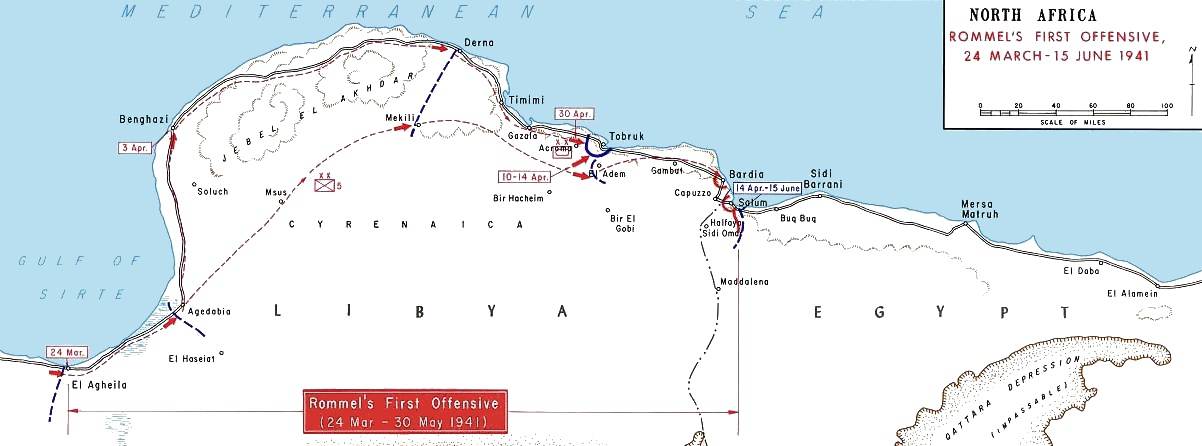 |
Above: The Western Desert area, showing Rommel’s first offensive, March 24 to June 15, 1941 (between arrows at bottom of map, admittedly difficult to see). Rommel caused havoc to British army fortunes in Northeast Africa, stopped only after Lt. Gen. Bernard Montgomery had assumed command of the British Eighth Army in August 1942. El Alamein, the site of a small railway station where Montgomery threw Rommel’s army into reverse in late October–early November 1942, appears at the right edge of this map.
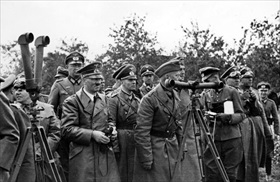 | 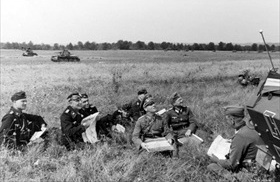 |
Left: Rommel (1891–1944) to Hitler’s left during the German “blitzkrieg” campaign in Poland, September 1939. Less than a year later Rommel employed the same techniques to great effect during the German rush through France in May and June 1940.
![]()
Right: Rommel with 7th Panzer Division staff in France, June 1940. Rommel’s Panzer division was the first German unit to reach the English Channel in the Wehrmacht’s drive to the French coast. The 7th Panzer captured Cherbourg on June 18 and was approaching Bordeaux when the French and the Germans signed an armistice on June 21, 1940. Almost a month earlier Rommel was awarded the Knight’s Cross of the Iron Cross, the first divisional commander to be so honored during the West European campaign.
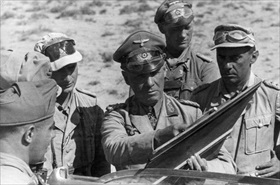 | 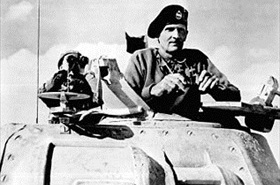 |
Left: The “Desert Fox” with his aides in North Africa, June 1942, on the eve of the First Battle of El Alamein (July 1–27, 1942). Although a stalemate, the battle halted a second advance by Rommel’s forces into Egypt. However, the German-Italian presence near El Alamein, only 66 miles from the major British port of Alexandria, Egypt, was dangerously close to major population centers and the Suez Canal for the Allied forces to allow the status quo to remain. A Second Battle of El Alamein under newly appointed Lt. Gen. Bernard Montgomery ended the Axis threat to Egypt, the Suez Canal, and any potential that the Germans might gain access to the Middle Eastern and Persian oil fields.
![]()
Right: Montgomery directing operations in North Africa, November 1942. Rommel exerted an almost hypnotic influence not only over his own troops on account of his tactical brilliance, bravery, and decency in his treatment of Allied prisoners (he was praised by no less a figure than Winston Churchill in January 1942) but also over the soldiers of the British Eighth Army in World War II. Montgomery kept a photograph of Rommel on the wall of his command trailer.
Erwin Rommel’s Afrika Korps Takes on British Commonwealth Forces in North Africa, 1941–1942
![]()

 History buffs, there is good news! The Daily Chronicles of World War II is now available as an ebook for $4.99 on Amazon.com. Containing a year’s worth of dated entries from this website, the ebook brings the story of this tumultuous era to life in a compelling, authoritative, and succinct manner. Featuring inventive navigation aids, the ebook enables readers to instantly move forward or backward by month and date to different dated entries. Simple and elegant! Click
History buffs, there is good news! The Daily Chronicles of World War II is now available as an ebook for $4.99 on Amazon.com. Containing a year’s worth of dated entries from this website, the ebook brings the story of this tumultuous era to life in a compelling, authoritative, and succinct manner. Featuring inventive navigation aids, the ebook enables readers to instantly move forward or backward by month and date to different dated entries. Simple and elegant! Click 











